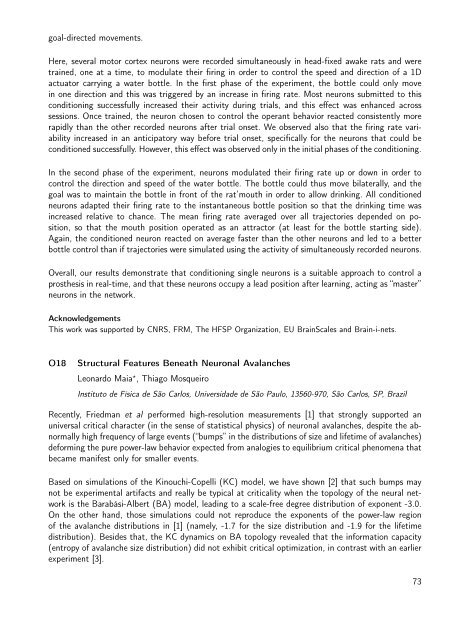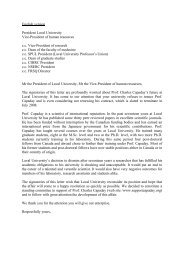Untitled - Laboratory of Neurophysics and Physiology
Untitled - Laboratory of Neurophysics and Physiology
Untitled - Laboratory of Neurophysics and Physiology
You also want an ePaper? Increase the reach of your titles
YUMPU automatically turns print PDFs into web optimized ePapers that Google loves.
goal-directed movements.<br />
Here, several motor cortex neurons were recorded simultaneously in head-fixed awake rats <strong>and</strong> were<br />
trained, one at a time, to modulate their firing in order to control the speed <strong>and</strong> direction <strong>of</strong> a 1D<br />
actuator carrying a water bottle. In the first phase <strong>of</strong> the experiment, the bottle could only move<br />
in one direction <strong>and</strong> this was triggered by an increase in firing rate. Most neurons submitted to this<br />
conditioning successfully increased their activity during trials, <strong>and</strong> this effect was enhanced across<br />
sessions. Once trained, the neuron chosen to control the operant behavior reacted consistently more<br />
rapidly than the other recorded neurons after trial onset. We observed also that the firing rate variability<br />
increased in an anticipatory way before trial onset, specifically for the neurons that could be<br />
conditioned successfully. However, this effect was observed only in the initial phases <strong>of</strong> the conditioning.<br />
In the second phase <strong>of</strong> the experiment, neurons modulated their firing rate up or down in order to<br />
control the direction <strong>and</strong> speed <strong>of</strong> the water bottle. The bottle could thus move bilaterally, <strong>and</strong> the<br />
goal was to maintain the bottle in front <strong>of</strong> the rat’mouth in order to allow drinking. All conditioned<br />
neurons adapted their firing rate to the instantaneous bottle position so that the drinking time was<br />
increased relative to chance. The mean firing rate averaged over all trajectories depended on position,<br />
so that the mouth position operated as an attractor (at least for the bottle starting side).<br />
Again, the conditioned neuron reacted on average faster than the other neurons <strong>and</strong> led to a better<br />
bottle control than if trajectories were simulated using the activity <strong>of</strong> simultaneously recorded neurons.<br />
Overall, our results demonstrate that conditioning single neurons is a suitable approach to control a<br />
prosthesis in real-time, <strong>and</strong> that these neurons occupy a lead position after learning, acting as “master”<br />
neurons in the network.<br />
Acknowledgements<br />
This work was supported by CNRS, FRM, The HFSP Organization, EU BrainScales <strong>and</strong> Brain-i-nets.<br />
O18<br />
Structural Features Beneath Neuronal Avalanches<br />
Leonardo Maia ⋆ , Thiago Mosqueiro<br />
Instituto de Física de São Carlos, Universidade de São Paulo, 13560-970, São Carlos, SP, Brazil<br />
Recently, Friedman et al performed high-resolution measurements [1] that strongly supported an<br />
universal critical character (in the sense <strong>of</strong> statistical physics) <strong>of</strong> neuronal avalanches, despite the abnormally<br />
high frequency <strong>of</strong> large events (“bumps” in the distributions <strong>of</strong> size <strong>and</strong> lifetime <strong>of</strong> avalanches)<br />
deforming the pure power-law behavior expected from analogies to equilibrium critical phenomena that<br />
became manifest only for smaller events.<br />
Based on simulations <strong>of</strong> the Kinouchi-Copelli (KC) model, we have shown [2] that such bumps may<br />
not be experimental artifacts <strong>and</strong> really be typical at criticality when the topology <strong>of</strong> the neural network<br />
is the Barabási-Albert (BA) model, leading to a scale-free degree distribution <strong>of</strong> exponent -3.0.<br />
On the other h<strong>and</strong>, those simulations could not reproduce the exponents <strong>of</strong> the power-law region<br />
<strong>of</strong> the avalanche distributions in [1] (namely, -1.7 for the size distribution <strong>and</strong> -1.9 for the lifetime<br />
distribution). Besides that, the KC dynamics on BA topology revealed that the information capacity<br />
(entropy <strong>of</strong> avalanche size distribution) did not exhibit critical optimization, in contrast with an earlier<br />
experiment [3].<br />
73



